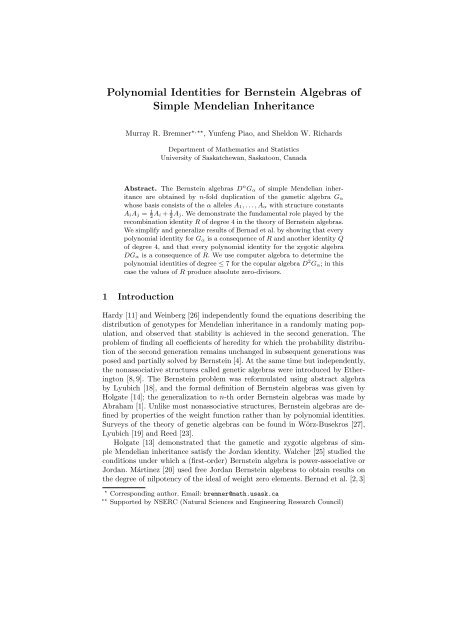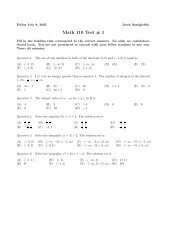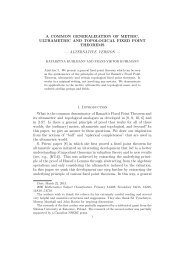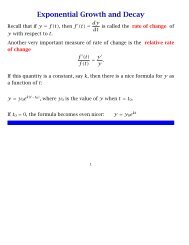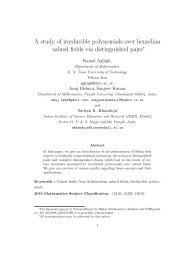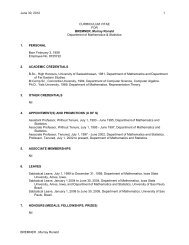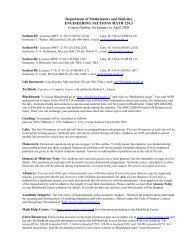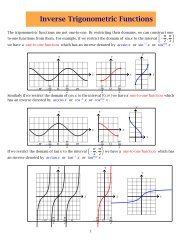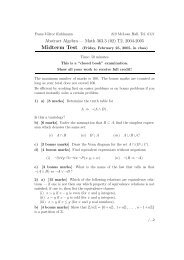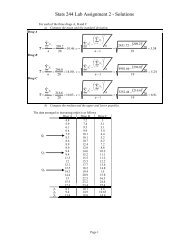Polynomial Identities for Bernstein Algebras of Simple Mendelian ...
Polynomial Identities for Bernstein Algebras of Simple Mendelian ...
Polynomial Identities for Bernstein Algebras of Simple Mendelian ...
Create successful ePaper yourself
Turn your PDF publications into a flip-book with our unique Google optimized e-Paper software.
<strong>Polynomial</strong> <strong>Identities</strong> <strong>for</strong> <strong>Bernstein</strong> <strong>Algebras</strong> <strong>of</strong><br />
<strong>Simple</strong> <strong>Mendelian</strong> Inheritance<br />
Murray R. Bremner ⋆,⋆⋆ , Yunfeng Piao, and Sheldon W. Richards<br />
Department <strong>of</strong> Mathematics and Statistics<br />
University <strong>of</strong> Saskatchewan, Saskatoon, Canada<br />
Abstract. The <strong>Bernstein</strong> algebras D n Gα <strong>of</strong> simple <strong>Mendelian</strong> inheritance<br />
are obtained by n-fold duplication <strong>of</strong> the gametic algebra Gα<br />
whose basis consists <strong>of</strong> the α alleles A1, . . . , Aα with structure constants<br />
AiAj = 1 1<br />
Ai + Aj. We demonstrate the fundamental role played by the<br />
2 2<br />
recombination identity R <strong>of</strong> degree 4 in the theory <strong>of</strong> <strong>Bernstein</strong> algebras.<br />
We simplify and generalize results <strong>of</strong> Bernad et al. by showing that every<br />
polynomial identity <strong>for</strong> Gα is a consequence <strong>of</strong> R and another identity Q<br />
<strong>of</strong> degree 4, and that every polynomial identity <strong>for</strong> the zygotic algebra<br />
DGα is a consequence <strong>of</strong> R. We use computer algebra to determine the<br />
polynomial identities <strong>of</strong> degree ≤ 7 <strong>for</strong> the copular algebra D 2 Gα; in this<br />
case the values <strong>of</strong> R produce absolute zero-divisors.<br />
1 Introduction<br />
Hardy [11] and Weinberg [26] independently found the equations describing the<br />
distribution <strong>of</strong> genotypes <strong>for</strong> <strong>Mendelian</strong> inheritance in a randomly mating population,<br />
and observed that stability is achieved in the second generation. The<br />
problem <strong>of</strong> finding all coefficients <strong>of</strong> heredity <strong>for</strong> which the probability distribution<br />
<strong>of</strong> the second generation remains unchanged in subsequent generations was<br />
posed and partially solved by <strong>Bernstein</strong> [4]. At the same time but independently,<br />
the nonassociative structures called genetic algebras were introduced by Etherington<br />
[8, 9]. The <strong>Bernstein</strong> problem was re<strong>for</strong>mulated using abstract algebra<br />
by Lyubich [18], and the <strong>for</strong>mal definition <strong>of</strong> <strong>Bernstein</strong> algebras was given by<br />
Holgate [14]; the generalization to n-th order <strong>Bernstein</strong> algebras was made by<br />
Abraham [1]. Unlike most nonassociative structures, <strong>Bernstein</strong> algebras are defined<br />
by properties <strong>of</strong> the weight function rather than by polynomial identities.<br />
Surveys <strong>of</strong> the theory <strong>of</strong> genetic algebras can be found in Wörz-Busekros [27],<br />
Lyubich [19] and Reed [23].<br />
Holgate [13] demonstrated that the gametic and zygotic algebras <strong>of</strong> simple<br />
<strong>Mendelian</strong> inheritance satisfy the Jordan identity. Walcher [25] studied the<br />
conditions under which a (first-order) <strong>Bernstein</strong> algebra is power-associative or<br />
Jordan. Mártinez [20] used free Jordan <strong>Bernstein</strong> algebras to obtain results on<br />
the degree <strong>of</strong> nilpotency <strong>of</strong> the ideal <strong>of</strong> weight zero elements. Bernad et al. [2, 3]<br />
⋆ Corresponding author. Email: bremner@math.usask.ca<br />
⋆⋆ Supported by NSERC (Natural Sciences and Engineering Research Council)
2 Bremner, Piao and Richards<br />
found a complete set <strong>of</strong> identities <strong>for</strong> the gametic and zygotic algebras <strong>of</strong> simple<br />
<strong>Mendelian</strong> inheritance on two alleles. López-Díaz et al. [17] studied <strong>Bernstein</strong><br />
algebras which satisfy the Glennie identities <strong>for</strong> special Jordan algebras. Correa<br />
et al. [7] (see also Peresi [22]) used computer algebra to determine the minimal<br />
polynomial identities satisfied by all <strong>Bernstein</strong> algebras, as well as normal and<br />
exceptional algebras. Hentzel et al. [12] used computer algebra to calculate the<br />
index <strong>of</strong> solvability <strong>of</strong> the ideal <strong>of</strong> all weight zero elements. <strong>Polynomial</strong> identities<br />
<strong>for</strong> second-order <strong>Bernstein</strong> algebras have been studied by Gónzalez et al.<br />
[10] and Labra et al. [15]. The operation <strong>of</strong> intermolecular recombination was<br />
<strong>for</strong>malized by Landweber and Kari [16], and its polynomial identity R <strong>of</strong> degree<br />
4 was discovered by Bremner [6]. It has recently been shown by Sverchkov [24]<br />
that any algebra satisfying R is a special Jordan algebra, and that R implies all<br />
the identities satisfied by intermolecular recombination.<br />
In Sect. 2 we recall basic results on nonassociative algebras and their polynomial<br />
identities; we introduce the gametic, zygotic and copular algebras <strong>of</strong> simple<br />
<strong>Mendelian</strong> inheritance on a finite number <strong>of</strong> alleles. In Sect. 3 we consider the<br />
gametic algebras; we simplify and generalize Theorem 2.1 <strong>of</strong> [3] by reducing the<br />
number <strong>of</strong> identities to two (the recombination identity R and another identity<br />
Q <strong>of</strong> degree 4) and proving that they hold <strong>for</strong> any number <strong>of</strong> alleles. In Sect. 4<br />
we consider the zygotic algebras; we simplify and generalize Theorem 3.2 <strong>of</strong> [3]<br />
by reducing the number <strong>of</strong> identities to one (the identity R) and proving that it<br />
holds <strong>for</strong> any number <strong>of</strong> alleles. In Sect. 5 we use computer algebra to determine<br />
the identities <strong>of</strong> degree ≤ 7 satisfied by the copular algebras: the first identities<br />
which do not follow from commutativity occur in degree 5; one <strong>of</strong> them states<br />
that the values <strong>of</strong> R give absolute zero-divisors; there are no new identities in<br />
degrees 6 or 7; unlike the gametic and zygotic algebras, the identities <strong>for</strong> two<br />
alleles differ from the identities <strong>for</strong> three or more alleles.<br />
2 Preliminaries<br />
Definition 1. An algebra A is a vector space over a field F with a bilinear<br />
product m: A × A → A, denoted (x, y) ↦→ m(x, y) = xy. We say that A is<br />
commutative if xy = yx <strong>for</strong> all x, y ∈ A.<br />
Definition 2. A weight function on an algebra A is a nonzero linear map<br />
ω : A → F which satisfies ω(xy) = ω(x)ω(y) <strong>for</strong> all x, y ∈ A. An algebra with a<br />
weight function is called a baric algebra.<br />
Definition 3. If A is commutative then the duplicate DA is the algebra with<br />
underlying vector space S 2 (A) and product (x1 ⊗ x2)(y1 ⊗ y2) = x1x2 ⊗ y1y2<br />
extended bilinearly; note that we do not define (x1 ⊗ x2)(y1 ⊗ y2) = x1y1 ⊗ x2y2.<br />
Lemma 4. If A is commutative then DA is commutative. If A is a baric algebra<br />
with weight function ω, then DA is a baric algebra whose weight function is the<br />
bilinear extension <strong>of</strong> ω(x1 ⊗ x2) = ω(x1)ω(x2).<br />
Pro<strong>of</strong>. Wörz-Busekros [27, Theorem 6.15, page 116]. ⊓⊔
<strong>Polynomial</strong> <strong>Identities</strong> <strong>for</strong> <strong>Bernstein</strong> <strong>Algebras</strong> 3<br />
Definition 5. The plenary powers <strong>of</strong> an element x ∈ A are defined by x [0] = x<br />
and x [n+1] = x [n] 2 <strong>for</strong> n ≥ 0. (Some authors write x [n+1] <strong>for</strong> our x [n] .)<br />
Definition 6. A <strong>Bernstein</strong> algebra <strong>of</strong> order n is a commutative baric algebra<br />
A which satisfies x [n+1] = ω(x) 2nx<br />
[n] <strong>for</strong> all x ∈ A.<br />
Lemma 7. If A is a <strong>Bernstein</strong> algebra <strong>of</strong> order n then its duplicate DA is a<br />
<strong>Bernstein</strong> algebra <strong>of</strong> order n+1.<br />
Pro<strong>of</strong>. Ouattara [21, Theorem 2.1]. ⊓⊔<br />
Definition 8. The gametic algebra Gα <strong>of</strong> simple <strong>Mendelian</strong> inheritance on α<br />
alleles is the commutative baric algebra with natural basis A1, A2, . . . , Aα, product<br />
AiAj = 1<br />
2Ai + 1<br />
2Aj <br />
and weight function ω i xiAi<br />
<br />
= i xi. The canonical<br />
basis is C1 = A1, Ci = Ai − A1 (i ≥ 2).<br />
Lemma 9. The canonical basis <strong>of</strong> Gα satisfies C2 1 = C1, C1Ci = 1<br />
2Ci (i ≥<br />
<br />
2), CiCj = 0 (i, j ≥ 2) and ω i xiCi<br />
<br />
= x1. The gametic algebra Gα is a<br />
<strong>Bernstein</strong> algebra <strong>of</strong> order 0.<br />
<br />
Pro<strong>of</strong>. One easily verifies that i aiCi<br />
2 <br />
= a1 i aiCi. ⊓⊔<br />
Definition 10. The duplicate <strong>of</strong> the gametic algebra Gα is the zygotic algebra<br />
DGα; the duplicate <strong>of</strong> the zygotic algebra is the copular algebra D 2 Gα.<br />
Duplication can be repeated indefinitely; Lemmas 7 and 9 imply that D n Gα is a<br />
<strong>Bernstein</strong> algebra <strong>of</strong> order n.<br />
Lemma 11. We have dim D n+1 Gα = dim D n Gα+1<br />
2<br />
. In particular,<br />
dim Gα = α , dim DGα = 1<br />
2 α(α+1) , dim D2 Gα = 1<br />
8 α(α+1)(α2 +α+2) .<br />
Pro<strong>of</strong>. Straight<strong>for</strong>ward. ⊓⊔<br />
Definition 12. A nonassociative monomial is a fully parenthesized string <strong>of</strong><br />
variables; a nonassociative polynomial is a linear combination <strong>of</strong> nonassociative<br />
monomials. A nonassociative polynomial is homogeneous if every monomial<br />
has the same degree; it is multilinear if each variable occurs exactly once<br />
in every monomial. A nonassociative polynomial I(x1, . . . , xn) is a polynomial<br />
identity <strong>for</strong> the algebra A if I(x1, . . . , xn) = 0 <strong>for</strong> all x1, . . . , xn ∈ A.<br />
Lemma 13. Any polynomial identity over a field <strong>of</strong> characteristic 0 is equivalent<br />
to a finite set <strong>of</strong> homogeneous multilinear identities.<br />
Pro<strong>of</strong>. Zhevlakov et al. [28, Chapter 1]. ⊓⊔<br />
Remark 14. Since D n Gα is commutative, we consider only homogeneous multilinear<br />
commutative nonassociative monomials. In a given degree d, such a monomial<br />
consists <strong>of</strong> a commutative association type (arrangement <strong>of</strong> parentheses)<br />
and a permutation <strong>of</strong> the d variables a1, . . . , ad. (See Example 16 below.)
4 Bremner, Piao and Richards<br />
Definition 15. We impose a total order on association types. For i =<br />
1, 2 let ti be commutative association types in degree d, let xi be the monomial<br />
consisting <strong>of</strong> the string a1 · · · ad with association type ti, and let xi = yizi be<br />
factorizations where yi and zi have association types t ′ i and t′′ i respectively. These<br />
factorizations are unique if we impose the conditions (i) deg yi > deg zi and<br />
(ii) if deg yi = deg zi then t ′ i precedes t′′ i in the total order already defined on<br />
association types <strong>of</strong> lower degree. We then say that t1 precedes t2 if and only if<br />
(i) deg x1 > deg x2 or (ii) deg x1 = deg x2 and t ′ 1 precedes t ′ 2.<br />
Example 16. The ordered commutative association types in degrees 3 to 6 are<br />
(ab)c , ((ab)c)d , (ab)(cd) ,<br />
(((ab)c)d)e , ((ab)(cd))e , ((ab)c)(de) .<br />
(((ab)c)d)e)f , (((ab)(cd)e)f , ((ab)c)(de))f ,<br />
((ab)c)d)(ef) , ((ab)(cd)(ef) , ((ab)c)((de)f) .<br />
Lemma 17. The number Cd <strong>of</strong> commutative association types in degree d is<br />
given by this <strong>for</strong>mula, where the binomial coefficient occurs only <strong>for</strong> even d:<br />
C1 = 1 , Cd =<br />
⌊(d−1)/2⌋ <br />
<br />
Cd/2 + 1<br />
Cd−iCi +<br />
.<br />
2<br />
i=1<br />
Pro<strong>of</strong>. Straight<strong>for</strong>ward. ⊓⊔<br />
Definition 18. We impose a total order on the monomials in each association<br />
type. Any type t in degree d has a number s <strong>of</strong> symmetries arising from<br />
commutativity, giving d!/2 s equivalence classes <strong>of</strong> monomials with type t. As representative<br />
<strong>of</strong> each class we choose the monomial whose underlying permutation<br />
comes first in lexicographical order.<br />
Example 19. In degree 3 there is one symmetry, (ab)c = (ba)c, giving three inequivalent<br />
monomials: (ab)c, (ac)b, (bc)a. In degree 4, the first type has one<br />
symmetry, ((ab)c)d = ((ba)c)d, and the second type has three symmetries,<br />
(ab)(cd) = (ba)(cd) = (ab)(dc) = (cd)(ab), giving 12 + 3 = 15 monomials:<br />
((ab)c)d , ((ab)d)c , ((ac)b)d , ((ac)d)b , ((ad)b)c , ((ad)c)b ,<br />
((bc)a)d , ((bc)d)a , ((bd)a)c , ((bd)c)a , ((cd)a)b , ((cd)b)a ,<br />
(ab)(cd) , (ac)(bd) , (ad)(bc) .<br />
Lemma 20. In degree d, the number <strong>of</strong> homogeneous multilinear commutative<br />
nonassociative monomials is (2d−3)!! where k!! = (k)(k−2) · · · (3)(1) <strong>for</strong> odd k.<br />
Pro<strong>of</strong>. Bremner [5, Proposition 1]. (The same pro<strong>of</strong> holds in the commutative<br />
case since the monomials are multilinear.) ⊓⊔
<strong>Polynomial</strong> <strong>Identities</strong> <strong>for</strong> <strong>Bernstein</strong> <strong>Algebras</strong> 5<br />
Definition 21. We write Pd <strong>for</strong> the space <strong>of</strong> nonassociative polynomials:<br />
the vector space with basis consisting <strong>of</strong> the (homogeneous multilinear commutative<br />
nonassociative) monomials <strong>of</strong> degree d. The symmetric group Sd acts on the<br />
monomials: omitting the association type, we set σ(ai1 · · · aid ) = a σ(i1) · · · a σ(id);<br />
we then replace the monomial by the standard representative <strong>of</strong> its equivalence<br />
class. This action <strong>of</strong> Sd does not change the association types and gives Pd the<br />
structure <strong>of</strong> an Sd-module.<br />
Lemma 22. The subspace I(A) ⊆ Pd consisting <strong>of</strong> the polynomial identities<br />
satisfied by the algebra A is an Sd-submodule <strong>of</strong> Pd.<br />
Pro<strong>of</strong>. If I is an identity <strong>for</strong> A then so is σI, and any linear combination <strong>of</strong><br />
identities <strong>for</strong> A is again an identity <strong>for</strong> A. ⊓⊔<br />
Definition 23. Let I(a1, . . . , ad) be an element <strong>of</strong> Pd. We introduce a new indeterminate<br />
ad+1 and define d + 1 elements <strong>of</strong> Pd+1, the liftings <strong>of</strong> I to degree<br />
d + 1: applying multiplication, and substitution <strong>for</strong> i = 1, . . . , d, we obtain<br />
I(a1, . . . , ad)ad+1 , and I(a1, . . . , aiad+1, . . . , ad) <strong>for</strong> 1 ≤ i ≤ d .<br />
The liftings <strong>of</strong> I generate the Sd+1-submodule <strong>of</strong> Pd+1 consisting <strong>of</strong> the identities<br />
in degree d + 1 which follow from I.<br />
3 Gametic <strong>Algebras</strong><br />
From now on, except as indicated, F is the field Q <strong>of</strong> rational numbers.<br />
Definition 24. We define polynomials I, J ∈ P4 and K ∈ P5:<br />
I = 2((ab)c)d − 2((ac)b)d − ((ad)b)c + ((ad)c)b ,<br />
J = ((ab)c)d + ((ab)d)c − ((ac)b)d − ((ad)b)c + ((cd)a)b − (ab)(cd) ,<br />
K = 2(((ab)c)d)e − 2(((ac)b)d)e − ((ab)c)(de) + ((ac)b)(de) .<br />
Theorem 25. Every identity satisfied by G2, the gametic algebra on two alleles,<br />
is a consequence <strong>of</strong> commutativity, I ≡ 0, J ≡ 0 and K ≡ 0.<br />
Pro<strong>of</strong>. Bernad et al. [3, Theorem 2.1]. ⊓⊔<br />
Definition 26. We define polynomials Q, R ∈ P4:<br />
Q = 3((ab)c)d − ((ab)d)c − 3((ac)b)d + ((ac)d)b ,<br />
R = 2((ab)c)d − ((ab)d)c − ((ac)b)d − ((bc)a)d + (ab)(cd) .<br />
R is the recombination identity satisfied by the operation <strong>of</strong> intermolecular<br />
recombination from the theory <strong>of</strong> <strong>for</strong>mal languages and DNA computing; see<br />
Landweber and Kari [16], Bremner [6], Sverchkov [24].<br />
Lemma 27. I and J generate the same S4-submodule <strong>of</strong> P4 as Q and R.
6 Bremner, Piao and Richards<br />
Pro<strong>of</strong>. It suffices to show that I and J can be expressed as linear combinations<br />
<strong>of</strong> permutations <strong>of</strong> Q and R, and conversely:<br />
4I = 3Q(a, b, c, d) + Q(a, b, d, c) − Q(a, c, d, b) ,<br />
8J = 6Q(a, b, c, d) + 3Q(a, b, d, c) + Q(a, c, d, b) + 3Q(b, a, c, d) − 3Q(c, a, d, b)<br />
− Q(c, b, d, a) − 8R(a, b, c, d) ,<br />
Q = 2I(a, b, c, d) − I(a, b, d, c) + I(a, c, d, b) ,<br />
2R = 2I(a, b, c, d) + I(a, c, d, b) + 2I(b, a, c, d) − I(b, a, d, c) + I(b, c, d, a)<br />
− I(c, a, d, b) − 2J(a, b, c, d) .<br />
These equations can be easily verified. (Each monomial must be “straightened”<br />
by applying commutativity: replacing it by its standard representative.) ⊓⊔<br />
Lemma 28. The identity K is a consequence <strong>of</strong> the identity Q.<br />
Pro<strong>of</strong>. We can express K as a linear combination <strong>of</strong> the liftings <strong>of</strong> Q:<br />
48K = 36 Q(a, b, c, d)e + 12 Q(a, b, d, c)e + 21 Q(a, b, e, c)d − 15 Q(a, b, e, d)c<br />
− 12 Q(a, c, d, b)e − 21 Q(a, c, e, b)d + 15 Q(a, c, e, d)b + 7 Q(a, d, e, b)c<br />
− 7 Q(a, d, e, c)b − 21 Q(b, a, e, c)d + 15 Q(b, a, e, d)c + 17 Q(b, c, e, a)d<br />
− 8 Q(b, c, e, d)a − 3 Q(b, d, e, a)c + 21 Q(c, a, e, b)d − 15 Q(c, a, e, d)b<br />
− 17 Q(c, b, e, a)d + 8 Q(c, b, e, d)a + 3 Q(c, d, e, a)b + 9 Q(d, a, e, b)c<br />
− 9 Q(d, a, e, c)b + 3 Q(d, b, e, a)c − 3 Q(d, c, e, a)b + 25 Q(ae, b, c, d)<br />
+ 20 Q(ad, b, c, e) − 9 Q(ae, b, d, c) + 12 Q(ad, b, e, c) + 9 Q(ae, c, d, b)<br />
− 12 Q(ad, c, e, b) − 24 Q(be, a, c, d) + 8 Q(be, a, d, c) + 24 Q(ce, a, b, d)<br />
− 8 Q(ce, a, d, b) + 6 Q(a, de, b, c) − 6 Q(a, de, c, b) − 18 Q(a, b, c, de) .<br />
This equation can be verified by lengthy hand calculations, or with a computer<br />
algebra system. There are 36 terms on the right side <strong>of</strong> the equation; each expands<br />
into a linear combination <strong>of</strong> 4 monomials. Of the resulting 144 monomials,<br />
24 must be replaced by the standard representative <strong>of</strong> the equivalence class; then<br />
only 52 distinct monomials remain in the expansion. Let C be the matrix <strong>of</strong> size<br />
52 × 36 in which Cij is the coefficient <strong>of</strong> monomial i in the expansion <strong>of</strong> term j.<br />
Summing over the rows <strong>of</strong> C we obtain the left side <strong>of</strong> the equation. ⊓⊔<br />
Remark 29. The equation <strong>of</strong> Lemma 28 was found as follows. There are 5 liftings<br />
<strong>of</strong> Q to degree 5: Q(a, b, c, d)e, Q(ae, b, c, d), Q(a, be, c, d), Q(a, b, ce, d) and<br />
Q(a, b, c, de); and five liftings <strong>of</strong> R. We construct a matrix L <strong>of</strong> size (105+120) ×<br />
105, initialized to zero. For each lifting, we apply the 120 permutations <strong>of</strong> the<br />
variables, store the results in the rows <strong>of</strong> the lower 120 × 120 block <strong>of</strong> L, and<br />
compute the row canonical <strong>for</strong>m; the lower block is now zero. The final rank is<br />
100: this is the dimension <strong>of</strong> the S5-submodule U ⊂ P5 consisting <strong>of</strong> identities in<br />
degree 5 implied by Q and R. Only five liftings increase the rank: U is generated<br />
by Q(a, b, c, d)e, Q(ae, b, c, d), Q(a, be, c, d), Q(a, b, c, de) and R(a, b, c, d)e. (See
<strong>Polynomial</strong> <strong>Identities</strong> <strong>for</strong> <strong>Bernstein</strong> <strong>Algebras</strong> 7<br />
Algorithm 40 below <strong>for</strong> a <strong>for</strong>malization <strong>of</strong> this procedure.) We construct a matrix<br />
<strong>of</strong> size 105 × 600 consisting <strong>of</strong> blocks <strong>of</strong> size 105 × 120. In column j <strong>of</strong> block k<br />
we put permutation j <strong>of</strong> generator k. We compute the row canonical <strong>for</strong>m; each<br />
column containing the leading 1 <strong>of</strong> a row corresponds to a basis vector <strong>of</strong> the<br />
column space. This gives 100 permutations <strong>of</strong> the generators <strong>for</strong>ming a linear<br />
basis <strong>of</strong> U. We <strong>for</strong>m a matrix <strong>of</strong> size 105 × 101 which has these basis elements<br />
in columns 1–100 and identity K in column 101. We compute the row canonical<br />
<strong>for</strong>m and obtain the coefficients <strong>of</strong> K as a linear combination <strong>of</strong> permutations<br />
<strong>of</strong> liftings <strong>of</strong> Q and R. (Note that R does not appear in the final result.)<br />
Theorem 30. The gametic algebras satisfy the same identities: <strong>for</strong> all α, every<br />
identity <strong>for</strong> Gα is a consequence <strong>of</strong> commutativity, Q ≡ 0 and R ≡ 0.<br />
Pro<strong>of</strong>. It follows from Theorem 25 and Lemmas 27 and 28 that every identity<br />
<strong>for</strong> Gα in the case α = 2 is a consequence <strong>of</strong> Q and R. Since G2 ⊆ Gα <strong>for</strong> all α,<br />
every identity <strong>for</strong> Gα is an identity <strong>for</strong> G2, and so in each degree the identities<br />
<strong>for</strong> Gα are a subspace <strong>of</strong> the identities <strong>for</strong> G2. It remains to show the converse:<br />
that Gα satisfies Q and R. It suffices to consider basis elements since Q and R<br />
are multilinear. Evaluating the association types in degree 4 we obtain<br />
<br />
Aℓ = 1<br />
<br />
AiAj Ak<br />
8Ai + 1<br />
8Aj + 1<br />
4Ak + 1<br />
2Aℓ ,<br />
<br />
1<br />
AiAj AkAℓ = 4Ai + 1<br />
4Aj + 1<br />
4Ak + 1<br />
4Aℓ .<br />
From this we obtain<br />
Q <br />
1 1 1<br />
Ai, Aj, Ak, Aℓ = 3 8Ai+ 8Aj+ 4<br />
− 3 1 1 1 1<br />
8Ai+ 4Aj+ 8Ak+ 2Aℓ <br />
1 + 8<br />
R <br />
1 1 1<br />
Ai, Aj, Ak, Aℓ = 2 8Ai+ 8Aj+ 4<br />
− 1 1 1 1<br />
8Ai+ 4Aj+ 8Ak+ 2Aℓ <br />
1 − 4<br />
+ 1 1 1 1<br />
4Ai+ 4Aj+ 4Ak+ 4Aℓ <br />
.<br />
1 Ak+ 2Aℓ 1 Ai+ 2<br />
1 Ak+ 2Aℓ Ai+ 1<br />
8<br />
<br />
1 1 1<br />
− 8Ai+ 8Aj+ 2<br />
1 1<br />
Aj+ 8Ak+ 4Aℓ <br />
,<br />
<br />
1 1 − 8Ai+ 8<br />
<br />
Aj+ 1<br />
8<br />
Ak+ 1<br />
2 Aℓ<br />
1 Ak+ 4Aℓ <br />
1 1<br />
Aj+ 2Ak+ 4Aℓ <br />
In both results all terms cancel. ⊓⊔<br />
4 Zygotic <strong>Algebras</strong><br />
The natural basis <strong>of</strong> DGα is Aij = Ai ⊗ Aj (1 ≤ i ≤ j ≤ g). Definition 3 gives<br />
AijAkℓ = 1<br />
4 Aik + 1<br />
4 Aiℓ + 1<br />
4 Ajk + 1<br />
4 Ajℓ .<br />
Definition 31. We define polynomials L, M, N (degree 4) and O, P (degree 5);<br />
note that L is the Jordan identity and that L, M, O are not multilinear:<br />
L = ((a 2 )b)a − a 2 (ab) , M = −2((ab)b)a + (b 2 a)a + a 2 b 2 ,<br />
N = ((ab)c)d − ((ab)d)c − ((bc)a)d + ((bc)d)a + ((bd)a)c − ((bd)c)a ,<br />
O = −2(((ab)c)c)d + 2(((bc)a)c)d − ((c 2 b)a)d + ((ab)c 2 )d ,<br />
P = (((ab)c)d)e − (((ad)c)b)e − (((bc)a)d)e + (((cd)a)b)e .
8 Bremner, Piao and Richards<br />
Theorem 32. Every identity satisfied by DG2, the zygotic algebra on two alleles,<br />
follows from commutativity, L ≡ 0, M ≡ 0, N ≡ 0, O ≡ 0 and P ≡ 0.<br />
Pro<strong>of</strong>. Bernad et al. [3, Theorem 3.2]. ⊓⊔<br />
Lemma 33. L, M and N are consequences <strong>of</strong> R, and conversely.<br />
Pro<strong>of</strong>. We easily verify that<br />
L = −R(a, a, a, b) , M = R(a, a, b, b) + R(a, b, a, b) − R(a, b, b, a) ,<br />
4N = 4R(a, b, c, d) + 4R(a, b, d, c) − 4R(a, c, d, b) + 3R(d, a, b, c) − 3R(d, a, c, b)<br />
+ 5R(d, b, a, c) − R(d, b, c, a) − 5R(d, c, a, b) − 3R(d, c, b, a) .<br />
We now linearize L and M, and make the leading coefficients 1, obtaining<br />
L(a, b, c, d) = ((ac)b)d + ((ad)b)c + ((cd)b)a − (ab)(cd) − (ac)(bd) − (ad)(bc) ,<br />
M(a, b, c, d) = ((ab)d)c + ((ad)b)c + ((bc)d)a − ((bd)a)c − ((bd)c)a + ((cd)b)a<br />
− 2(ac)(bd) ,<br />
2R(a, b, c, d) = −2L(a, b, c, d) + L(a, c, b, d) − L(a, d, b, c) + M(a, b, c, d)<br />
+ M(a, b, d, c) + 2N(a, b, c, d) − N(a, c, b, d) + N(a, d, b, c) .<br />
The last equation can be easily verified. ⊓⊔<br />
Lemma 34. O and P are consequences <strong>of</strong> R.<br />
Pro<strong>of</strong>. We have the equations<br />
O = 3R(a, b, d, c)c−R(a, c, b, c)d−4R(a, c, d, b)c+R(a, c, d, c)b+2R(a, d, b, c)c<br />
−2R(a, d, c, b)c+R(b, c, a, c)d+R(b, c, c, a)d+3R(b, d, a, c)c+R(b, d, c, a)c<br />
−2R(c, d, a, b)c−R(c, d, a, c)b−R(c, d, b, a)c−R(ab, c, c, d)+R(ab, c, d, c)<br />
+R(ac, b, c, d)−R(ac, b, d, c)+R(ac, d, b, c)−R(ac, d, c, b)−R(cd, a, b, c)<br />
+R(cd, a, c, b) ,<br />
4P = 4R(a, b, c, d)e+4R(a, b, d, c)e−4R(a, c, d, b)e+3R(a, d, b, c)e−5R(a, d, c, b)e<br />
+6R(a, d, e, b)c+2R(a, e, b, d)c+6R(a, e, d, b)c+R(b, d, a, c)e+3R(b, d, c, a)e<br />
−8R(b, d, e, a)c+8R(b, d, e, c)a−2R(b, e, a, d)c+2R(b, e, c, d)a−4R(b, e, d, a)c<br />
+4R(b, e, d, c)a−3R(c, d, a, b)e−3R(c, d, b, a)e−6R(c, d, e, b)a−2R(c, e, b, d)a<br />
−6R(c, e, d, b)a+4R(d, e, a, b)c−4R(d, e, b, a)c+4R(d, e, b, c)a−4R(d, e, c, b)a<br />
−2R(ad, b, c, e)+2R(ad, b, e, c)+2R(bd, a, c, e)−2R(bd, a, e, c)−2R(bd, c, a, e)<br />
+2R(bd, c, e, a)+2R(bd, e, a, c)−2R(bd, e, c, a)−2R(be, d, a, c)+2R(be, d, c, a)<br />
−2R(cd, b, e, a)+2R(cd, b, a, e) .<br />
These can be verified by tedious but straight<strong>for</strong>ward calculation. ⊓⊔<br />
Theorem 35. The zygotic algebras satisfy the same identities: <strong>for</strong> all α, every<br />
identity <strong>for</strong> DGα is a consequence <strong>of</strong> commutativity and R.
<strong>Polynomial</strong> <strong>Identities</strong> <strong>for</strong> <strong>Bernstein</strong> <strong>Algebras</strong> 9<br />
Pro<strong>of</strong>. It follows from Theorem 32 and Lemmas 33 and 34 that every identity <strong>for</strong><br />
DGα in the case α = 2 is a consequence <strong>of</strong> R. Since DG2 ⊆ DGα <strong>for</strong> all α, every<br />
identity <strong>for</strong> DGα is an identity <strong>for</strong> DG2, and so in each degree the identities <strong>for</strong><br />
DGα are a subspace <strong>of</strong> the identities <strong>for</strong> DG2. It remains to show the converse:<br />
that DGα satisfies R. In the natural basis, we ignore the assumption that i ≤ j<br />
and identify Aij with Aji. We first compute the general product in degree 3:<br />
<br />
AijAkℓ Aim+Ain+Ajm+Ajn+Akm+Akn+Aℓm+Aℓn .<br />
Amn = 1<br />
8<br />
For the first association type in degree 4, we have<br />
<br />
AijAkℓ Amn Apq =<br />
<br />
1<br />
1<br />
1<br />
16<br />
Aip+Aiq+Ajp+Ajq + 16<br />
Akp+Akq+Aℓp+Aℓq + 8<br />
Amp+Amq+Anp+Anq ,<br />
and there<strong>for</strong>e<br />
2 <br />
AijAkℓ Amn Apq − <br />
AijAkℓ Apq Amn − <br />
AijAmn Akℓ Apq<br />
− <br />
AkℓAmn Aij Apq = − 1<br />
<br />
16<br />
Aim + Ain + Ajm + Ajn + Aip + Aiq<br />
<br />
.<br />
+ Ajp + Ajq + Akm + Akn + Aℓm + Aℓn + Akp + Akq + Aℓp + Aℓq<br />
For the second association type in degree 4, we have<br />
<br />
1<br />
AijAkℓ AmnApq = 16<br />
Aim + Ain + Aip + Aiq + Ajm + Ajn<br />
+ Ajp + Ajq + Akm + Akn + Akp + Akq + Aℓm + Aℓn + Aℓp + Aℓq<br />
Adding the last two results gives R <br />
Aij, Akℓ, Amn, Apq ≡ 0. ⊓⊔<br />
5 Copular <strong>Algebras</strong><br />
The natural basis <strong>of</strong> D2Gα consists <strong>of</strong> Aijkℓ = Aij ⊗ Akℓ with 1 ≤ i ≤ j ≤ α,<br />
1 ≤ k ≤ ℓ ≤ α, and either i < k or i = k, j < ℓ. The structure constants are<br />
AijkℓAmnop = 1<br />
<br />
16<br />
Aikmo+Aikmp+Aikno+Aiknp+Aiℓmo+Aiℓmp+Aiℓno<br />
+Aiℓnp+Ajkmo+Ajkmp+Ajkno+Ajknp+Ajℓmo+Ajℓmp+Ajℓno+Ajℓnp<br />
where we identify Aijkℓ, Aijℓk, Ajikℓ, Ajiℓk, Akℓij, Aℓkij, Akℓji, Aℓkji. Little is<br />
known about identities <strong>for</strong> D 2 Gα even when α = 2; in particular, there is no<br />
known generating set <strong>for</strong> the identities <strong>of</strong> D 2 G2 as <strong>for</strong> G2 and DG2. In this<br />
section our pro<strong>of</strong>s are primarily computational. We <strong>of</strong>ten use arithmetic modulo<br />
p = 101 so that each matrix entry fits in one byte. Modular arithmetic is essential<br />
in higher degrees when the matrices are large; it saves memory, but requires<br />
reconstruction <strong>of</strong> rational coefficients from modular coefficients and independent<br />
verification <strong>of</strong> the rational results.<br />
Lemma 36. Every identity <strong>of</strong> degree ≤ 4 satisfied by D 2 Gα (α ≥ 2) is a consequence<br />
<strong>of</strong> commutativity. In particular, D 2 Gα does not satisfy the identity R.<br />
.<br />
,
10 Bremner, Piao and Richards<br />
Pro<strong>of</strong>. Since any identity in degree d implies identities in degree d+1, it suffices<br />
to prove that D 2 Gα has no identities in degree 4. Since D 2 G2 ⊆ D 2 Gα, the<br />
identities <strong>for</strong> D 2 Gα are a subspace <strong>of</strong> the identities <strong>for</strong> D 2 G2, and it suffices to<br />
show that D 2 G2 has no identities in degree 4. We can use modular arithmetic,<br />
since non-existence <strong>of</strong> identities over IFp implies non-existence over Q. (If I is a<br />
nontrivial identity over Q, we multiply by the lcm <strong>of</strong> the denominators <strong>of</strong> the<br />
coefficients, then divide by the gcd <strong>of</strong> the coefficients to get a primitive identity,<br />
and finally reduce mod p to get a nontrivial identity over IFp.) We abbreviate<br />
the natural basis <strong>of</strong> D 2 G2 by U = A1111, V = A1112, W = A1122, X = A1212,<br />
Y = A1222, Z = A2222. Using p = 101 we then have U 2 = U, UV = V U = 51V ,<br />
UX = XU = 76W , V 2 = 76X, V X = XV = 38Y , X 2 = 19Z, and all other<br />
products are 0. There are 15 ordered monomials Mi in degree 4 (Example 19),<br />
so we need to find 15 linearly independent constraints on their coefficients xi.<br />
Evaluating each monomial Mi with abcd = UUV V we obtain a multiple <strong>of</strong> W or<br />
X; <strong>for</strong> example, ((ab)c)d = ((UU)V )V = 38X, (ab)(cd) = (UU)(V V ) = 19W .<br />
We obtain these constraints:<br />
60x4 + 60x6 + 60x8 + 60x10 + 19x13 = 0 ,<br />
38x1 + 38x2 + 19x3 + 19x5 + 19x7 + 19x9 + 19x14 + 19x15 = 0 .<br />
Setting abcd equal to UV UV , UV V U, V UUV , V UV U, V V UU, we get another<br />
10 constraints, <strong>for</strong> a total <strong>of</strong> 12. Setting abcd equal to UUV X, UV UX, UV XU,<br />
we find that every monomial produces a multiple <strong>of</strong> Y , giving another 3 constraints.<br />
The resulting 15 × 15 coefficient matrix has full rank. ⊓⊔<br />
Definition 37. The expansion matrix in degree d <strong>for</strong> a commutative nonassociative<br />
algebra A <strong>of</strong> dimension r is a matrix Ed with (2d−3)!! + r rows and<br />
(2d−3)!! columns, regarded as an upper block <strong>of</strong> size (2d−3)!! × (2d−3)!! and<br />
a lower block <strong>of</strong> size r × (2d−3)!!. Column j corresponds to the j-th ordered<br />
monomial <strong>of</strong> degree d.<br />
Algorithm 38 (Fill and Reduce).<br />
Input: Positive integers d (degree <strong>of</strong> identities), p (upper limit <strong>of</strong> pseudorandom<br />
integers) and s (number <strong>of</strong> iterations required with stable rank). This<br />
algorithm calls a procedure which evaluates the product in the algebra A <strong>of</strong><br />
dimension r whose elements are written as column vectors in a given basis.<br />
Output: Once the rank has stabilized, the nullspace <strong>of</strong> the expansion matrix<br />
contains the polynomial identities <strong>of</strong> degree d satisfied by the algebra A.<br />
1. Initialize the expansion matrix Ed to zero.<br />
2. Repeat until the rank <strong>of</strong> Ed has not increased <strong>for</strong> s iterations:<br />
(a) Generate d pseudorandom elements x1, . . . , xd ∈ A: column vectors <strong>of</strong><br />
length r with components in {0, 1, . . . , p−1}.<br />
(b) For j = 1, 2, . . . , (2d − 3)!!, evaluate the j-th monomial (a permutation<br />
<strong>of</strong> a1, . . . , ad with an association type) <strong>for</strong> ak = xk (k = 1, . . . , d) and<br />
store the result in column j <strong>of</strong> the lower block.<br />
(c) Compute the row canonical <strong>for</strong>m <strong>of</strong> Ed; the lower block is now zero.
<strong>Polynomial</strong> <strong>Identities</strong> <strong>for</strong> <strong>Bernstein</strong> <strong>Algebras</strong> 11<br />
Definition 39. The generator matrix <strong>for</strong> commutative nonassociative identities<br />
in degree d is a matrix Md with (2d−3)!! + d! rows and (2d−3)!! columns,<br />
regarded as an upper block <strong>of</strong> size (2d−3)!! × (2d−3)!! and a lower block <strong>of</strong> size<br />
d! × (2d−3)!!. Column j corresponds to the j-th ordered monomial <strong>of</strong> degree d.<br />
Row i <strong>of</strong> the lower block corresponds to the i-th permutation <strong>of</strong> the d variables.<br />
Algorithm 40 (Module Generators).<br />
Input: An ordered set <strong>of</strong> Sd-module generators I1, . . . , Ik <strong>for</strong> a submodule<br />
U ⊆ Pd <strong>of</strong> identities in degree d satisfied by the algebra A.<br />
Output: The minimal ordered subset which generates U in the sense that each<br />
element is not a member <strong>of</strong> the submodule generated by the previous elements.<br />
1. Initialize the generator matrix Md to zero. Set oldrank = 0.<br />
2. For ℓ = 1, . . . , k do:<br />
(a) Set i = 0.<br />
(b) For each σ ∈ Sd do:<br />
i. Increment i.<br />
ii. Apply σ to each monomial in Iℓ and replace the resulting monomial<br />
by the standard representative <strong>of</strong> its equivalence class.<br />
iii. Store the resulting permuted identity σIℓ in row i <strong>of</strong> the lower block.<br />
(c) Compute the row canonical <strong>for</strong>m <strong>of</strong> Md; the lower block is now zero.<br />
(d) Set newrank = rank(Md).<br />
(e) If newrank > oldrank then record Iℓ as a new generator.<br />
(f) Set oldrank = newrank.<br />
Definition 41. We define polynomials S, T ∈ P5:<br />
S = ((ab)d)(ce)−((ab)e)(cd)+((ac)d)(be)−((ac)e)(bd)+((bc)d)(ae)−((bc)e)(ad),<br />
T = ((ab)d)(ce)−((ac)e)(bd)+((ad)b)(ce)−((ae)c)(bd)−((bd)a)(ce)+((ce)a)(bd).<br />
Theorem 42. Every identity <strong>of</strong> degree ≤ 7 satisfied by the copular algebras<br />
D 2 Gα <strong>for</strong> α ≥ 3 is a consequence <strong>of</strong> commutativity, R(a, b, c, d)e = 0, S ≡ 0 and<br />
T ≡ 0. (These identities are also satisfied by the copular algebra <strong>for</strong> α = 2.)<br />
Pro<strong>of</strong>. Lemma 36 shows that D 2 G3 satisfies no identities in degree ≤ 4. For the<br />
computations in this pro<strong>of</strong> we used the Maple package LinearAlgebra[Modular]<br />
with p = 101. The nonzero products in D 2 G3 (mod p) are:<br />
A1111A1111 = A1111 , A1111A1112 = 51A1112 , A1111A1113 = 51A1113 ,<br />
A1111A1212 = 76A1122 , A1111A1213 = 76A1123 , A1111A1313 = 76A1133 ,<br />
A1112A1112 = 76A1212 , A1112A1113 = 76A1213 , A1112A1212 = 38A1222 ,<br />
A1112A1213 = 38A1223 , A1112A1313 = 38A1233 , A1113A1113 = 76A1313 ,<br />
A1113A1212 = 38A1322 , A1113A1213 = 38A1323 , A1113A1313 = 38A1333 ,<br />
A1212A1212 = 19A2222 , A1212A1213 = 19A2223 , A1212A1313 = 19A2233 ,<br />
A1213A1213 = 19A2323 , A1213A1313 = 19A2333 , A1313A1313 = 19A3333 .
12 Bremner, Piao and Richards<br />
Step 1: We show that D 2 G3 satisfies nontrivial identities in degree 5 over<br />
IFp; we find a linear basis <strong>for</strong> the space <strong>of</strong> identities and a set <strong>of</strong> generators <strong>for</strong><br />
the S5-module <strong>of</strong> identities. There are 105 monomials in degree 5, and D 2 G3 has<br />
dimension 21, so the expansion matrix has size 126 × 105. The first iteration <strong>of</strong><br />
Algorithm 38 generates these 5 pseudorandom elements <strong>of</strong> D 2 G3:<br />
58 91 36 15 16 99 0 77 62 33 57 93 50 44 49 49 33 76 96 5 79<br />
15 43 54 6 11 7 32 52 36 97 72 89 0 16 77 65 50 94 100 65 28<br />
54 6 37 71 68 65 12 61 72 61 98 81 90 65 85 77 39 93 9 2 65<br />
14 54 45 87 41 55 7 63 43 98 25 17 29 65 3 63 57 72 90 89 11<br />
31 34 83 19 100 54 2 27 6 75 49 74 31 7 8 26 84 77 69 26 62<br />
We evaluate the monomials on these elements, store the results in the lower block<br />
<strong>of</strong> the expansion matrix, and compute the row canonical <strong>for</strong>m; the rank is 21.<br />
The second iteration generates another 5 elements, and again fills and reduces<br />
the expansion matrix; the rank is 40. After the third iteration the rank is 45; we<br />
per<strong>for</strong>m another 100 iterations but the rank does not increase. It follows that<br />
the space <strong>of</strong> identities has dimension 105 − 40 = 60. From the row canonical<br />
<strong>for</strong>m we extract the canonical basis <strong>for</strong> the nullspace. We sort these 60 identities<br />
by increasing number <strong>of</strong> nonzero components. Using Algorithm 40 we find that<br />
identity 1 generates an S5-submodule <strong>of</strong> dimension 45, identities 2–35 belong<br />
to the submodule generated by identity 1, identity 36 increases the dimension<br />
to 55, and identity 37 increases the dimension to 60 (the entire nullspace). It<br />
follows that every identity <strong>of</strong> degree 5 follows from commutativity and identities<br />
1, 36 and 37: these are R(a, b, c, d)e ≡ 0, S ≡ 0 and T ≡ 0.<br />
Step 2a. From each identity I(a, b, c, d, e) in degree 5 we get six liftings:<br />
I(a, b, c, d, e)f , I(af, b, c, d, e) , I(a, bf, c, d, e) ,<br />
I(a, b, cf, d, e) , I(a, b, c, df, e) , I(a, b, c, d, ef) .<br />
Applying Algorithm 40 to these 18 identities we find seven identities that generate<br />
the same S6-module:<br />
(R(a, b, c, d)e)f , R(af, b, c, d)e , R(a, b, c, d)(ef) , S(af, b, c, d, e) ,<br />
S(a, b, c, df, e) , T (af, b, c, d, e) , T (a, bf, c, d, e) .<br />
These identities cumulatively generate submodules <strong>of</strong> dimensions 270, 570, 705,<br />
786, 826, 835 and 840.<br />
Step 2b: There are 945 monomials in degree 6, so the expansion matrix has<br />
size 966 × 945. The first 7 iterations <strong>of</strong> Algorithm 38 produce ranks 21, 41, 60,<br />
75, 90, 102 and 105; we then per<strong>for</strong>m another 100 iterations but the rank does<br />
not increase. It follows that the S6-module <strong>of</strong> identities <strong>for</strong> D 2 G3 has dimension<br />
945 − 105 = 840. Since this is also the dimension <strong>of</strong> the lifted identities, it<br />
follows that every identity in degree 6 is a consequence <strong>of</strong> commutativity and<br />
the identities in degree 5.<br />
Step 3: We extend these computations to degree 7; the expansion matrix has<br />
size 10416 × 10395. The 49 liftings <strong>of</strong> the 7 identities from degree 6 generate an
<strong>Polynomial</strong> <strong>Identities</strong> <strong>for</strong> <strong>Bernstein</strong> <strong>Algebras</strong> 13<br />
S7-module <strong>of</strong> dimension 10185. The stable rank <strong>of</strong> the expansion matrix is 210,<br />
and so the nullspace has dimension 10395 − 210 = 10185. Thus every identity in<br />
degree 7 is a consequence <strong>of</strong> commutativity and the identities in degree 5.<br />
Step 4: Since D 2 G3 ⊆ D 2 Gα <strong>for</strong> α ≥ 3, it follows that the space <strong>of</strong> identities<br />
<strong>of</strong> D 2 Gα is contained in the space <strong>of</strong> identities <strong>for</strong> D 2 G3. We verify that the three<br />
identities in degree 5 are satisfied by D 2 Gα over Q by independent computations<br />
with the copular algebra on 20 alleles, as follows. Since each identity has degree<br />
5 and is multilinear, and each natural basis element has 4 subscripts, we take<br />
a = A1,2,3,4 , b = A5,6,7,8 , c = A9,10,11,12 , d = A13,14,15,16 , e = A17,18,19,20 ,<br />
in the algebra D 2 G20. (We regard subscript j as short <strong>for</strong> the indeterminate<br />
subscript ij.) An identity in degree 5 does not involve more than 20 alleles even<br />
in an algebra on α > 20 alleles, so this is the general case. For α there is a<br />
surjective homomorphism Φ from D 2 G20 to the subalgebra <strong>of</strong> D 2 Gα generated<br />
by any 5 natural basis elements: if j ↦→ φ(j) is any function from {1, . . . , 20} to<br />
{1, . . . , a} then Φ(Aj1j2j3j4) = A f(j1)f(j2)f(j3)f(j4). We now use arithmetic over Q<br />
to evaluate the three identities in degree 5 on the elements a, b, c, d, e ∈ D 2 G20,<br />
and find that each identity collapses to 0. It follows that the identities <strong>of</strong> the<br />
Theorem are satisfied over Q by D 2 Gα <strong>for</strong> α ≥ 3, and hence the identities <strong>for</strong><br />
D 2 G3 are the same as the identities <strong>for</strong> D 2 Gα <strong>for</strong> α ≥ 3. ⊓⊔<br />
Definition 43. We define polynomials U, V ∈ P5:<br />
U = ((ab)c)(de) − ((ab)d)(ce) − ((ac)b)(de) + ((ac)d)(be) + ((ad)b)(ce)<br />
− ((ad)c)(be) ,<br />
V = 3((ab)c)(de) + 2((ac)b)(de) − 2((ac)e)(bd) + ((ad)b)(ce) − 4((ad)e)(bc)<br />
− 3((bc)a)(de) + 3((cd)b)(ae) .<br />
Theorem 44. Every identity <strong>of</strong> degree ≤ 7 satisfied by the copular algebra<br />
D 2 Gα <strong>for</strong> α = 2 is a consequence <strong>of</strong> commutativity, R(a, b, c, d)e = 0, U ≡ 0<br />
and V ≡ 0. The identities U and V are not satisfied by D 2 Gα <strong>for</strong> α ≥ 3.<br />
Pro<strong>of</strong>. The pro<strong>of</strong> <strong>of</strong> the first claim is similar to that <strong>of</strong> Theorem 42. (For two<br />
alleles, the space <strong>of</strong> identities in degree 5 has dimension 65.) For the second<br />
claim, since D 2 G3 ⊆ D 2 Gα <strong>for</strong> α ≥ 3, it suffices to show that U and V are<br />
not satisfied by D 2 G3. For a = A1111, b = A1111, c = A1112, d = A1113 and<br />
e = A1112, both U(a, b, c, d, e) and V (a, b, c, d, e) are equal to<br />
15A1122 + 86A1123 + 86A1212 + 15A1213 + 15A1223 + 86A1322 .<br />
Since the result is nonzero over IFp, it is also nonzero over Q. ⊓⊔<br />
Corollary 45. The following element is an absolute zero-divisor in the copular<br />
algebra D 2 Gα over Q <strong>for</strong> any α ≥ 2 and any i1, . . . , i16 ∈ {1, . . . , α}:<br />
R(Ai1i2i3i4, Ai5i6i7i8, Ai9i10i11i12, Ai13i14i15i16) =
14 Bremner, Piao and Richards<br />
− 1<br />
64<br />
4<br />
8<br />
14<br />
16<br />
p=1 q=5 r=13 s=15<br />
+ 1<br />
256<br />
4<br />
8 12<br />
p=1 q=5 r=9 s=13<br />
Aipiqiris − 1<br />
128<br />
16<br />
8<br />
Aipiqiris + 1<br />
128<br />
16<br />
10<br />
12<br />
p=1 q=13 r=9 s=11<br />
12<br />
14<br />
8<br />
Aipiqiris<br />
16<br />
p=1 q=9 r=13 s=15<br />
Aipiqiris .<br />
Pro<strong>of</strong>. The identity R(a, b, c, d)e ≡ 0 says that the values <strong>of</strong> the recombination<br />
identity are absolute zero-divisors in every copular algebra D 2 Gα. ⊓⊔<br />
Example 46. The algebra D 2 G2 has dimension 6 and natural basis A1111, A1112,<br />
A1122, A1212, A1222, A2222. For each <strong>of</strong> the 6 4 assignments in lexicographical<br />
order <strong>of</strong> these basis elements to a, b, c, d we compute the element R(a, b, c, d).<br />
We record the assignments which produce a result linearly independent <strong>of</strong> the<br />
previous results. We obtain a subspace <strong>of</strong> absolute zero-divisors with basis<br />
R(A1111, A1111, A1112, A1112) = 1<br />
16 A1111 − 1<br />
8 A1112 + 1<br />
16 A1122 ,<br />
R(A1111, A1111, A1112, A1212) =<br />
1<br />
16A1111 − 1<br />
16A1112 + 1<br />
16A1122 − 1<br />
8A1212 + 1<br />
16A1222 ,<br />
R(A1111, A1112, A1112, A1212) =<br />
References<br />
5<br />
128A1111 − 1<br />
32A1112 + 3<br />
64A1122 − 3<br />
32A1212 + 1<br />
32A1222 + 1<br />
128A2222 .<br />
1. Abraham, V. M.: Linearizing quadratic trans<strong>for</strong>mations in genetic algebras. Proc.<br />
London Math. Soc. 40 (1980) 346–363.<br />
2. Bernad, J., González, S., Martínez, C., Iltyakov, A. V.: On identities <strong>of</strong> baric<br />
algebras and superalgebras. J. Algebra 197 (1997) 385–408.<br />
3. Bernad, J., González, S., Martínez, C., Iltyakov, A. V.: <strong>Polynomial</strong> identities <strong>of</strong><br />
<strong>Bernstein</strong> algebras <strong>of</strong> small dimension. J. Algebra 207 (1998) 664–681.<br />
4. <strong>Bernstein</strong>, S.: Solution <strong>of</strong> a mathematical problem connected with the theory <strong>of</strong><br />
heredity. Ann. Math. Statistics 13 (1942) 53–61.<br />
5. Bremner, M. R.: Varieties <strong>of</strong> anticommutative n-ary algebras. J. Algebra 191 (1997)<br />
76–88.<br />
6. Bremner, M. R.: Jordan algebras arising from intermolecular recombination.<br />
SIGSAM Bull. 39 (2005) 106-117.<br />
7. Correa, I., Hentzel, I. R., Peresi, L. A.: Minimal identities <strong>of</strong> <strong>Bernstein</strong> algebras.<br />
<strong>Algebras</strong> Groups Geom. 11 (1994) 181–199.<br />
8. Etherington, I. M. H.: Genetic algebras. Proc. Royal Soc. Edinburgh 59 (1939)<br />
242–258.<br />
9. Etherington, I. M. H.: Nonassociative algebra and the symbolism <strong>of</strong> genetics. Proc.<br />
Royal Soc. Edinburgh 61 (1941) 24–42.<br />
10. González, S., Vicente, P., Mártinez, C.: Power-associative and Jordan second-order<br />
<strong>Bernstein</strong> algebras. Nova J. Algebra Geom. 2 (1993) 367–381.<br />
11. Hardy, G. H.: <strong>Mendelian</strong> proportions in a mixed population. Science 28 (1908)<br />
49–50.
<strong>Polynomial</strong> <strong>Identities</strong> <strong>for</strong> <strong>Bernstein</strong> <strong>Algebras</strong> 15<br />
12. Hentzel, I. R., Jacobs, D. P., Peresi, L. A., Sverchkov, S. R.: Solvability <strong>of</strong> the<br />
ideal <strong>of</strong> all weight zero elements in <strong>Bernstein</strong> algebras. Comm. Algebra 22 (1994)<br />
3265–3275.<br />
13. Holgate, P.: Jordan algebras arising in population genetics. Proc. Edinburgh Math.<br />
Soc. 15 (1966/1967) 291–294.<br />
14. Holgate, P.: Genetic algebras satisfying <strong>Bernstein</strong>’s stationarity principle. J. London<br />
Math. Soc. 9 (1974/75) 612–623.<br />
15. Labra, A., Mallol, C., Suazo, A.: A characterization <strong>of</strong> power-associative <strong>Bernstein</strong><br />
algebras <strong>of</strong> order 2. Nova J. Algebra Geom. 3 (1994) 83–96.<br />
16. Landweber, L., Kari, L.: The evolution <strong>of</strong> cellular computing: nature’s solution to<br />
a computational problem. Biosystems 52 (1999) 3–13.<br />
17. López-Díaz, M., Shestakov, I. P., Sverchkov, S. R.: On speciality <strong>of</strong> <strong>Bernstein</strong><br />
Jordan algebras. Comm. Algebra 28 (2000) 4375–4387.<br />
18. Lyubich, Y. I.: Basic concepts and theorems <strong>of</strong> the evolutionary genetics <strong>of</strong> free<br />
populations. Russian Math. Surveys 26 (1971) 51–124.<br />
19. Lyubich, Y. I.: Mathematical Structures in Population Genetics. Springer-Verlag,<br />
Berlin, 1992.<br />
20. Martínez, C.: On nuclear Jordan-<strong>Bernstein</strong> algebras. J. Algebra 174 (1995) 453–<br />
472.<br />
21. Ouattara, M.: Sur les algèbres de <strong>Bernstein</strong> d’ordre 2. Linear Algebra Appl. 144<br />
(1991) 29–38.<br />
22. Peresi, L. A.: A basis <strong>of</strong> identities <strong>for</strong> <strong>Bernstein</strong> algebras. Int. J. Math. Game<br />
Theory Algebra 14 (2004) 179–188.<br />
23. Reed, M. L.: Algebraic structure <strong>of</strong> genetic inheritance. Bull. Amer. Math. Soc. 34<br />
(1997) 107–130.<br />
24. Sverchkov, S. R.: Structure and representations <strong>of</strong> Jordan algebras arising from<br />
intermolecular recombination. Jordan Theory Preprint Archives, 25 May 2007:<br />
homepage.uibk.ac.at/~c70202/jordan/archive/IR/index.html<br />
25. Walcher, S.: <strong>Bernstein</strong> algebras which are Jordan algebras. Arch. Math. 50 (1988)<br />
218–222.<br />
26. Weinberg, W.: On the demonstration <strong>of</strong> heredity in man. in: Samuel H. Boyer<br />
(editor), Papers on Human Genetics, Prentice-Hall, Englewood Cliffs, 1963.<br />
27. Wörz-Busekros, A.: <strong>Algebras</strong> in Genetics. Springer-Verlag, Berlin, 1980.<br />
28. Zhevlakov, K. A., Slinko, A. M., Shestakov, I. P., Shirshov, A. I.: Rings That Are<br />
Nearly Associative. Academic Press, New York, 1982.


